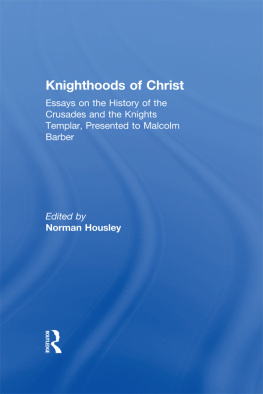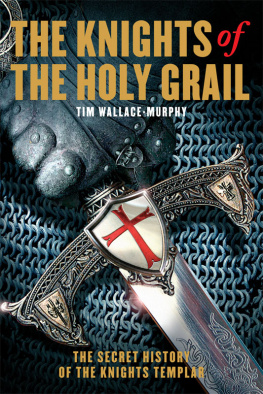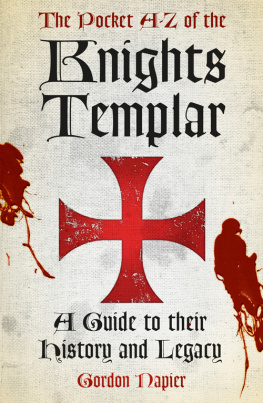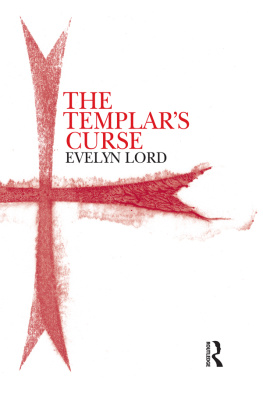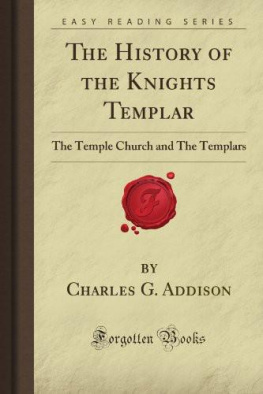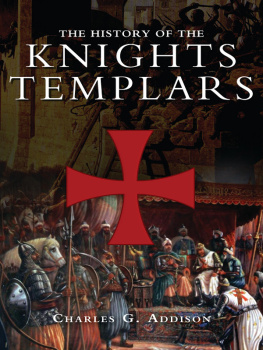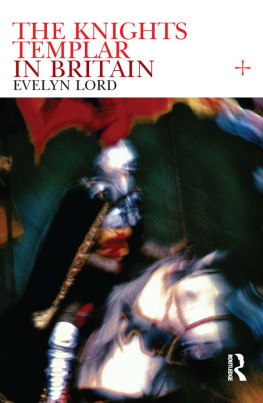Knighthoods of Christ

Malcolm Barber
First published 2007 by Ashgate Publishing
Published 2016 by Routledge
2 Park Square, Milton Park, Abingdon, Oxon OX14 4RN
711 Third Avenue, New York, NY 10017, USA
Routledge is an imprint of the Taylor & Francis Group, an informa business
Copyright 2007 Norman Housley
Norman Housley has asserted his moral right under the Copyright, Designs and Patents Act, 1988, to be identified as the editor of this work.
All rights reserved. No part of this book may be reprinted or reproduced or utilised in any form or by any electronic, mechanical, or other means, now known or hereafter invented, including photocopying and recording, or in any information storage or retrieval system, without permission in writing from the publishers.
Notice:
Product or corporate names may be trademarks or registered trademarks, and are used only for identification and explanation without intent to infringe.
British Library Cataloguing in Publication Data
Knighthoods of Christ: Essays on the History of the Crusades and the Knights Templar,
Presented to Malcolm Barber
1.Templars. 2.Crusades. I.Housley, Norman
909.07
Library of Congress Cataloging-in-Publication Data
Knighthoods of Christ: Essays on the History of the Crusades and the Knights Templar,
Presented to Malcolm Barber / edited by Norman Housley.
p. cm.
Chiefly in English with one contribution in French.
Includes bibliographical references and index.
1. Crusades. 2. Templars History. 3. Islam Relations Christianity. I. Housley,
Norman.
D160.K45 2007
909.07dc22
2006016612
Cover illustration: Matthew Pariss drawing of the Templar seal in his Historia Anglorum, depicting two knights sharing a horse in commemoration of their orders humble origins. British Library, Royal MS 14C VII, fol. 42v. Reproduced by permission of the British Library.
ISBN 9780754655275 (hbk)
Contents
Anne Curry
Judi Upton-Ward
John France, University of Wales, Swansea
Thomas S. Asbridge, Queen Mary, University of London
Alan V. Murray, University of Leeds
Jonathan Phillips, Royal Holloway, University of London
Marianne J. Ailes, University of Reading and Wadham College Oxford
Peter Noble, University of Reading
Susan B. Edgington, Huntingdon
Jaroslav Folda, University of North Carolina
Norman Housley, University of Leicester
Alain Demurger, Cergy
Jonathan Riley-Smith, Emmanuel College, Cambridge
Peter W. Edbury, Cardiff University
Luis Garca-Guijarro, Universidad de Zaragoza
Alan Forey, Kirtlington
Helen J. Nicholson, Cardiff University
Anne Gilmour-Bryson, Vancouver
Sophia Menache, University of Haifa
Genealogical Tables
Figures
Maps
The term militia Christi (knighthood of Christ) was used in the central Middle Ages to describe both individuals who had taken the cross and professed members of the Order of the Temple in Jerusalem (the Knights Templar). It is appropriate as the title for a collection of essays given to Malcolm Barber because Malcolm has illuminated both of these fields of research, quite apart from others such as the history of the Cathars and the Albigensian Crusade. Our hope was that the collection would include a contribution by Malcolms PhD supervisor, Bernard Hamilton, but circumstances have made this impossible, and Professor Hamiltons essay will be published elsewhere.
It has been a pleasure to edit the volume, and I am grateful to John Smedley of Ashgate for agreeing to publish it, to the contributors for their courteous and willing assistance, and to Judi Upton-Ward for compiling the bibliography of Malcolms works, complete to 2005. Thanks are also due to Helen Nicholson and Jonathan Riley-Smith for advice on technical matters relating to the Templars.
NORMAN HOUSLEY
February 2006
Anne Curry
I rate him among the top one per cent of history academics I know. Were I ever given the opportunity to create a department from scratch, Malcolm Barber would be among my first appointments.
I will not embarrass Malcolm by disclosing who said this of him, but I hope that neither he nor the ex-colleague who made the comment will object to my opening this appreciation with it. It provides in a nutshell why this festschrift has come about at all. Malcolm is both an exceptionally distinguished scholar and an excellent colleague and friend, and I was delighted to be invited to contribute to this volume.
His intellectual journey began in West London, more precisely at the Walpole Grammar School, Ealing, which he attended between 1954 and 1961. In the autumn of 1961, he went up to Nottingham University to read History, graduating with a first-class degree three years later. He then began research on the grand masters of the Order of the Temple under Bernard Hamilton, a formidable scholar in his own right who played a vital role in Malcolms formation as a historian and who has been a close friend ever since those early days. It was at Nottingham too that Malcolm met someone else who shaped his destiny (and cultivated his passion for gardening) his wife, Elizabeth. Malcolms family has always been central to his life and activities, through his children Ruth and David, and now through his grandchildren. I am sure that I am not the only contributor to, or reader of, this festschrift who has reason to be grateful to the Barbers for their friendship and hospitality over many years. Their home-grown raspberries are amongst the finest in the Thames Valley, and Elizabeth is an excellent chef as well as pianist. One of these days we will persuade Malcolm to sing!
No sooner had he completed the second year of his postgraduate research based at the British School at Rome than he was appointed to a temporary post in 1966 at the University of Reading as an assistant lecturer at the princely sum of 1,105 per annum. There he formed part of the Nottingham mafia under James Holt, recently translated as Professor of Medieval History to Reading. He was offered a permanent post in April 1969. The letter from the Registrar, addressed Dear Barber, reminds us that the swinging sixties took some time to undermine the social protocols beloved of British universities. Even when I joined the Reading Department in 1978, staff were still able to enjoy tea and coffee in china cups served by liveried staff, and to relax in the Faculty of Letters and Social Sciences Senior Common Room on chairs on which the Queen had gazed when she opened the building in the mid-1950s. Subsequent modifications of that room very much sum up the changes in universities which Malcolm has experienced over his career. Porcelain gave way to polystyrene, and staff to students, until finally the room was re-equipped as the hub of staff training and quality assurance events.
It may come as a surprise that Malcolm was very nearly lost to the medieval world after he completed his doctorate in 1968. Moving in the opposite direction to Dom David Knowles, whose first work was on the American Civil War, Malcolm at one time toyed with a project on urban life 18651900 which aimed at examining the living conditions and underlying philosophies of those who dealt with and wrote about the social problems created by the rapid urbanisation of the USA. The choice of topic is characteristic of Malcolms life-long interest in and concern for the disadvantaged in society. At his retirement from Reading in 2005, he asked not for the customary gifts for himself, but that donations be made to Water Aid.

